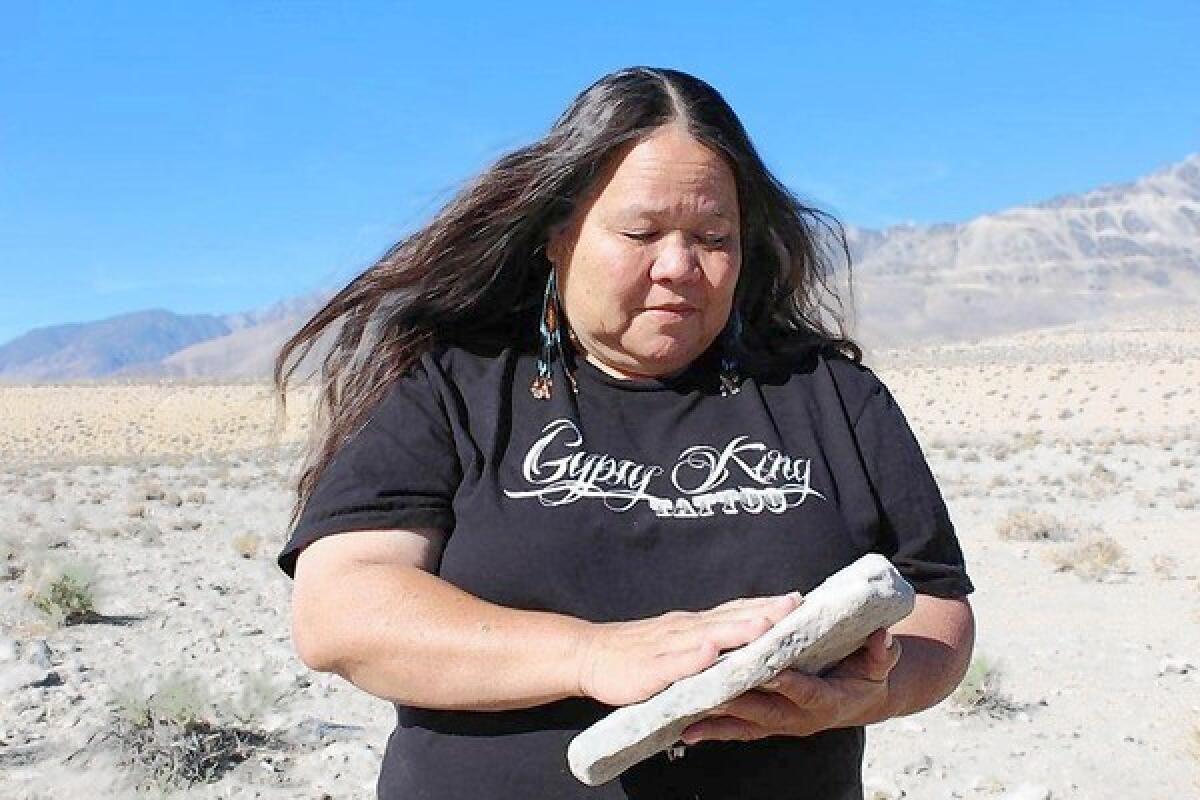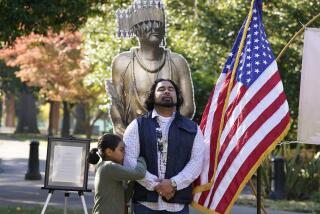DWP archaeologists uncover grim chapter in Owens Valley history

LONE PINE, Calif. — Oral histories of Native Americans and U.S. Cavalry records offer insights into a horrific massacre here in 1863: Thirty-five Paiute Indians were chased into Owens Lake by settlers and soldiers to drown or be gunned down.
But the records are silent on one important point. Exactly where did the massacre occur on the moonlit night of March 19, 1863?
An archaeological find in what is today a vast alkali playa has revealed a cache of bullets, musket balls, cavalry uniform buttons and Native American artifacts that Paiute tribal members and researchers believe are evidence of the grim chapter in Owens Valley history.
The site has been lost to history for more than 100 years, a time in which Los Angeles drained most of Owens Lake to slake the growing city’s thirst. Strong winds and torrential rain in 2009 may have uncovered the artifacts, which were found by Los Angeles Department of Water and Power archaeologists surveying the area in preparation for dust mitigation projects.
Dust wasn’t a problem in the mid-19th century at Owens Lake, 200 miles north of Los Angeles. Native Paiutes hunted along the lake and diverted the flow of local streams to irrigate fields of wild hyacinth and yellow nutgrass.
But disputes arose as settlers poured into the valley and began ranching on the tribe’s pasturelands. U.S. troops were sent to protect the settlers and the land and water they had effectively stolen from the Paiutes.
By 1860, the Paiutes’ land had been overrun with cattle and sheep. Tensions spiked when Paiutes took down a settler’s cow or ox to eat during the severe winter of 1861.
During the Owens Valley Indian War, between 1861 and 1866, ranchers — backed by troops — and the Paiutes tried to wipe each other out. Paiute homes and stores of food were destroyed. Paiutes fought back with bows and arrows, and a few guns.
On March 19, 1863, 20 soldiers and 10 white settlers attacked Paiutes who were reportedly killing livestock in the area. The battle began in a nearby oak grove and the Paiutes ran into the lake, hoping to swim to safety.
However, “a strong wind was blowing from the east and the Indians could make little progress in swimming against it; therefore they became easy targets for the men hunting them,” historian Dorothy Clora Cragen wrote in her book, “The Boys in the Sky-Blue Pants.”
After taking a shot at one of the Indians trying to swim beyond the range of gunfire, a white settler raised his fist and shouted, “Die, damn you, in the lake!” she wrote. “And the Indian did.”
“Darkness came on but there was a bright moon, and the soldiers and citizens formed a line along the … shore, and remained there until the bodies began to wash ashore,” Cragen wrote. Only two Paiutes are thought to have survived that day.
DWP archaeologists discovered the site a year ago, but its existence had been kept private to prevent looting and vandalism. Now, a nasty dispute between the department and air pollution authorities is forcing it into the open.
The site is on a section of the lake bed that state air pollution authorities say contributes to choking dust storms in the Owens Valley. As the lake was drained over the last century, it left vast salt flats prone to sending up powder-fine dust that often exceeds federal health standards.
Sixteen years ago, on orders from the Great Basin Unified Air Pollution Control District, the DWP embarked on a $1.2-billion campaign to mitigate dust with shallow flooding and gravel.
The effort largely succeeded, but air pollution officials said the DWP needed to do more. Over the objections of the utility, Great Basin called for mitigation measures on other portions of the lake bed — including the land where the DWP later made its discovery. Now, the utility is siding with Paiutes who want to make the area off-limits to dust mitigation projects.
On a recent weekday, Kathy Jefferson Bancroft, tribal historic preservation officer for the Lone Pine Paiute-Shoshone Reservation, brushed away dirt from an ancient grinding stone she had found a few minutes earlier along a stretch of lake bed shoreline sparkling with shards of volcanic glass and chert left by ancient Paiutes making tools and arrowheads.
Nearby mounds of rocks harbored the newly discovered remains of her ancestors killed in the massacre. Cragen’s research found that only Paiute men were slain that day, but Bancroft says that women and children were among the victims.
“Just over there, 150 years ago, our people ran into the water and then were picked off,” she said, nodding toward a silent expanse of cracked clay and salt.
“We take this personally — my grandmother told me about this massacre and she knew the people it happened to,” she said. “This ground, and the artifacts in it, is who we are.”
Brancroft said the land should be left undisturbed. “These artifacts do not belong to archaeologists. They belong here. They are not ours to bother.”
Great Basin, the DWP and local tribal leaders are trying to strike a compromise that would spare the site from disturbance. It also would avoid a showdown in court between requirements of the federal Clean Air Act and laws that protect historical artifacts: the National Historic Preservation Act and the Native American Graves Protection and Repatriation Act.
One alternative under discussion would ban construction on the massacre site and have the DWP mitigate dust on roughly 350 acres of land elsewhere in Owens Valley.
DWP spokesman Joe Ramallo said the utility believes the site, as well as other land where archaeologists have found artifacts, should not be disturbed by mitigation efforts. He said the department’s proposal would “protect these areas, improve habitat, control dust and save water and our customers’ money.”
Great Basin air pollution control officer Ted D. Schade said the DWP and his agency are making progress.
“For the longest time, Great Basin has had a hard time even having a rational discussion with the DWP,” Schade said. “This discovery has opened up relations that are more fruitful.
“You don’t come across massacre sites very often,” he said.
ALSO:
Powerhouse fire bears down on lake communities
Riding a wave of history and commemoration in Santa Monica
Museum trustee says legal action possible in USC parking deal
More to Read
Sign up for Essential California
The most important California stories and recommendations in your inbox every morning.
You may occasionally receive promotional content from the Los Angeles Times.











